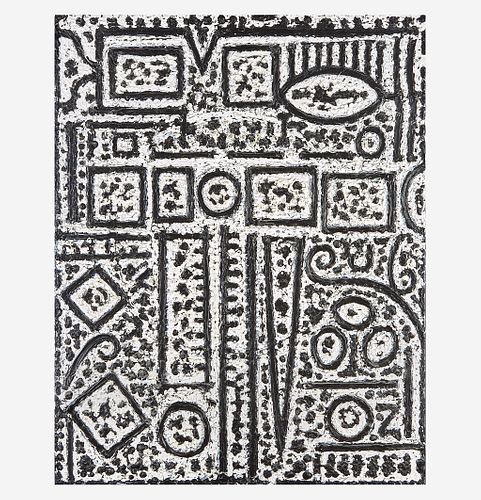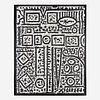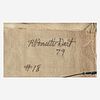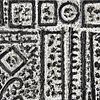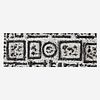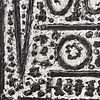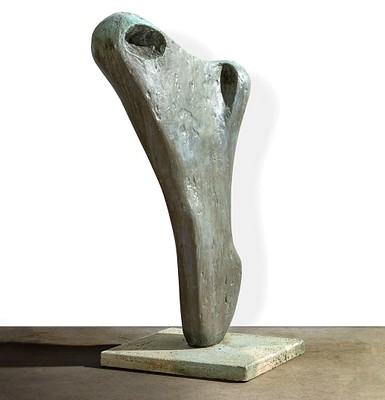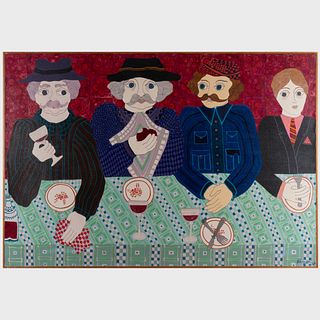Richard Pousette-Dart (American, 1916-1992) Small Cathedral
About Seller
2400 Market St
Philadelphia, PA 19147
United States
Established in 1805, Freeman’s Auction House holds tradition close, with a progressive mind-set towards marketing and promotion, along with access to a team of top experts in the auction business. And now with offices in New England, the Southeast, and on the West Coast, it has never been easier to ...Read more
Two ways to bid:
- Leave a max absentee bid and the platform will bid on your behalf up to your maximum bid during the live auction.
- Bid live during the auction and your bids will be submitted real-time to the auctioneer.
Bid Increments
| Price | Bid Increment |
|---|---|
| $0 | $25 |
| $500 | $50 |
| $1,000 | $100 |
| $2,000 | $200 |
| $3,000 | $250 |
| $5,000 | $500 |
| $10,000 | $1,000 |
| $20,000 | $2,000 |
| $30,000 | $2,500 |
| $50,000 | $5,000 |
| $100,000 | $10,000 |
About Auction
May 11, 2021
A collection of Modern and Contemporary art including an etching from William Kentridge's Sleeper Series. Curated by David Weiss, Senior Vice President and Head of Sale for the Modern and Contemporary Art department at Freeman's. Freeman's info@freemansauction.com
- Lot Description
Richard Pousette-Dart (American, 1916-1992) Small Cathedral
Signed, dated 79 and inscribed #18 verso, titled on stretcher in another hand, acrylic on linen.
(42 x 33 in. (106.7 x 83.8cm))Provenance
Obelisk Gallery, Inc., Boston, Massachusetts.
Private Collection, Pennsylvania.
Footnote:Note
One of the founders of Abstract Expressionism, Richard Pousette-Dart was born in Minnesota to two creative parents, his mother a poet and musician and his father a painter, writer, and art director. The family moved east to Valhalla, New York in 1918, and Pousette-Dart attended Bard College in 1936 for just one year. He then decided to pursue his artistic career independently, moving to New York City and working as an artist’s assistant, while experimenting with his own photography, sculpture, drawing, and painting. While living in the city, the artist made frequent trips to the Natural History Museum, as he was particularly fascinated by Native American art in the collection, drawing on the universal quality of the forms and shapes he observed in the works on view for his own experimentation.
Pousette-Dart gained early recognition and had his first solo exhibition at the Artists’ Gallery in New York, in 1941, shortly thereafter beginning to work on a monumental scale, creating some of the first mural-sized Abstract Expressionist canvases. He went on to show at Howard Putzel’s gallery, as well as Peggy Guggenheim’s Art of This Century, before joining the Betty Parsons Gallery in 1948, which represented his fellow New York School artists Mark Rothko, Jackson Pollock, and Clyfford Still, and where Pousette-Dart began a long-standing association. Preferring the solitude of life outside of the city, Pousette-Dart relocated upstate in 1951, where he maintained a residence and studio for the rest of his life.
The artist continued to work and exhibit with the Abstract Expressionst painters even after his move, and in 1950 joined the protest of the Metropolitan Museum of Art’s juried exhibition “American Painting Today,” claiming the museum held contempt for modern painting and had no intention of showing “advanced art” in the exhibition. Pousette-Dart posed for a now-famous photograph titled “The Irascibles,” with Pollock, Still, Rothko, Robert Motherwell, Willem de Kooning, and others, that was published in Life Magazine in 1951, along with a story of the artists’ protest. This publicity helped popularize the term Abstract Expressionist and solidify the group as an important force in modern American art. Later in life, Pousette-Dart held teaching positions at the Art Students League, Columbia University, and Sarah Lawrence College. His work is in museum collections around the world and he has been the subject of several ambitious retrospective exhibitions, at the Indianapolis Museum of Art and the Whitney Museum of American Art.
Pousette-Dart painted in vibrant, pulsating color as often as in a reduced black and white palette, as seen here in Small Cathedral from 1979. The painting incorporates geometric and biomorphic shapes, playing on the universal forms and iconography the artist referred to again and again in his work, brought to life by a thickly applied impasto of acrylic paint. The dance of dots and lines, measured out along the canvas, create a playful surface that carries the eye around and up and down, providing a new experience every time it is engaged. Pousette-Dart once said “I strive to express the spiritual nature of the Universe. Painting for me is a dynamic balance and wholeness of life; it is mysterious and transcending, yet solid and real.” [1] Standing like a black and white stained-glass window, the painting calls to mind other “cathedral” works by the artist, including a ten-by-ten foot bronze panel in the collection of the Indianapolis Museum of Art, from 1990. Created more than ten years after Small Cathedral, the panel engages with similar themes, executed in light and dark bronze surfaces on a grandiose scale. A playful late work by a well-known artist, Small Cathedral encapsulates the painter’s life-long project, bringing an energy and universality to the fundamental experience of abstraction.
[1] Richard Pousette-Dart: Drawings, exh. cat., Chicago: Arts Club of Chicago, 1978. - Shipping Info
-
No lot may be removed from Freeman’s premises until the buyer has paid in full the purchase price therefor including Buyer’s Premium or has satisfied such terms that Freeman’s, in its sole discretion, shall require. Subject to the foregoing, all Property shall be paid for and removed by the buyer at his/ her expense within ten (10) days of sale and, if not so removed, may be sold by Freeman’s, or sent by Freeman’s to a third-party storage facility, at the sole risk and charge of the buyer(s), and Freeman’s may prohibit the buyer from participating, directly or indirectly, as a bidder or buyer in any future sale or sales. In addition to other remedies available to Freeman’s by law, Freeman’s reserves the right to impose a late charge of 1.5% per month of the total purchase price on any balance remaining ten (10) days after the day of sale. If Property is not removed by the buyer within ten (10) days, a handling charge of 2% of the total purchase price per month from the tenth day after the sale until removal by the buyer shall be payable to Freeman’s by the buyer. Freeman’s will not be responsible for any loss, damage, theft, or otherwise responsible for any goods left in Freeman’s possession after ten (10) days. If the foregoing conditions or any applicable provisions of law are not complied with, in addition to other remedies available to Freeman’s and the Consignor (including without limitation the right to hold the buyer(s) liable for the bid price) Freeman’s, at its option, may either cancel the sale, retaining as liquidated damages all payments made by the buyer(s), or resell the property. In such event, the buyer(s) shall remain liable for any deficiency in the original purchase price and will also be responsible for all costs, including warehousing, the expense of the ultimate sale, and Freeman’s commission at its regular rates together with all related and incidental charges, including legal fees. Payment is a precondition to removal. Payment shall be by cash, certified check or similar bank draft, or any other method approved by Freeman’s. Checks will not be deemed to constitute payment until cleared. Any exceptions must be made upon Freeman’s written approval of credit prior to sale. In addition, a defaulting buyer will be deemed to have granted and assigned to Freeman’s, a continuing security interest of first priority in any property or money of, or owing to such buyer in Freeman’s possession, and Freeman’s may retain and apply such property or money as collateral security for the obligations due to Freeman’s. Freeman’s shall have all of the rights accorded a secured party under the Pennsylvania Uniform Commercial Code.
-
- Buyer's Premium



 EUR
EUR CAD
CAD AUD
AUD GBP
GBP MXN
MXN HKD
HKD CNY
CNY MYR
MYR SEK
SEK SGD
SGD CHF
CHF THB
THB